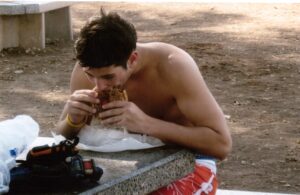This is a Hebrew translation of my annual dvar Torah for Pesach in memory of my son Niot z”l, whom we lost ten years ago during Pesach. A pdf file of the Hebrew original, which appears in this week’s issue of “Shabbat Shalom,” the weekly Torah sheet published by Oz Veshalom, the religious peace movement, can be downloaded here.
 At the beginning of the Seder, before we begin the magid, the telling of the story of the exodus from Egypt, we perform a ritual called yahatz. We break, according to most customs, the middle of the three matzot that we have placed on the table along with the other signs of the holiday. We set the larger piece aside or conceal it so that it will serve after the meal as the afikoman.
At the beginning of the Seder, before we begin the magid, the telling of the story of the exodus from Egypt, we perform a ritual called yahatz. We break, according to most customs, the middle of the three matzot that we have placed on the table along with the other signs of the holiday. We set the larger piece aside or conceal it so that it will serve after the meal as the afikoman.
At the end of the magid we make two blessings on the matzot that remain on the table—the two whole ones and the piece that remains of the middle one. According to one opinion (as in, for example, the commentary on the Haggadah of Rabbi Yitzhak Mirsky), the two blessings are intended for different combinations of these matzot. The hamotzi blessing, the one we use all year before eating bread and which on Shabbatot and holidays we make over two loaves, as part of the happiness of the occasion, is the blessing over the two whole matzot. The second blessing, al ahilat matzah, specific to the fulfilment of the command to eat matzah on the Seder night, is directed at one whole matzah and the broken matzah. The broken one represents the concept of lehem oni, usually translated into English as “the bread of affliction.”





